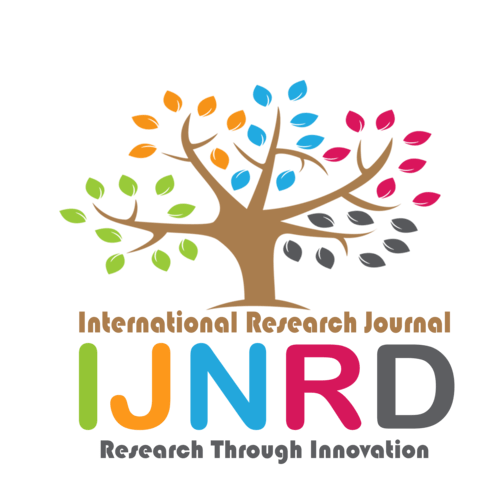|
|||||||||||||||

|
INTERNATIONAL JOURNAL OF NOVEL RESEARCH AND DEVELOPMENT International Peer Reviewed & Refereed Journals, Open Access Journal ISSN Approved Journal No: 2456-4184 | Impact factor: 8.76 | ESTD Year: 2016 Scholarly open access journals, Peer-reviewed, and Refereed Journals, Impact factor 8.76 (Calculate by google scholar and Semantic Scholar | AI-Powered Research Tool) , Multidisciplinary, Monthly, Indexing in all major database & Metadata, Citation Generator, Digital Object Identifier(DOI) |
||||||||||||||
Issue: April 2024
Volume 9 | Issue 4
Review Result and Publication of Paper within : 2-3 days
Click Here For more DetailsFor Authors
Forms / Download
Published Issue Details
Editorial Board
Other IMP Links
Facts & Figure
Impact Factor : 8.76
Issue per Year : 12
Volume Published : 9
Issue Published : 95
Article Submitted :
Article Published :
Total Authors :
Total Reviewer :
Total Countries :
Indexing Partner
Join RMS/Earn 300
Licence
This work is licensed under a Creative Commons Attribution-NonCommercial 4.0 International License







|
Published Paper Details
|
|
| Paper Title: | Assessment Of The Comparative Analysis Of The Ayurvedic Medicine And Pathya Aahar With Allopathic Medicine In Type 2 Diabetes Mellitus Individuals: A Cross-Sectional Comparative Study |
| Authors Name: | Shamika Harishchandra Girkar , Dr.Rekha Battalwar , Dr. Jagmeet Madan , Dr. Ajay Salunke , Dr. Balaji Sawant |
| Download E-Certificate: | Download |
| Author Reg. ID: |
IJNRD_181918
|
| Published Paper Id: | IJNRD2206118 |
| Published In: | Volume 7 Issue 6, June-2022 |
| DOI: | |
| Abstract: | Background: Diabetes is one of the largest global health emergencies of this century, ranking among the 10 leading causes of mortality together with cardiovascular disease (CVD), respiratory disease, and cancer. Ayurveda, as well as modern literature, approaches health from two perspectives, first the preventive aspect where the aim is sustaining health in healthy and the second one the curative aspect which aims at the treatment of the manifested diseases. Ayurveda places special emphasis on "Ahara" (diet) and "Anna" (food) as a means to the good life, health, and wellness. Along with the dietary aspect which consists of pathya and apathya, Ayurveda looks into the Prakriti of the participants and lays emphasis on yoga asanas. Aim: The study aims to look into 3 key aspects - pathya apathya aahar, Prakriti, and yoga asanas between the patients who follow the ayurvedic treatment regimen and those who follow the allopathic treatment regimen Methodology: A cross-sectional study was conducted in Mumbai among 100 type 2 diabetic participants, among them, 50 were from the allopathic treatment regimes and 50 were from ayurvedic treatment regimes, between 20-60 years of age. Data was collected, in which, information related to general demographic characteristics, questions pertaining to pathya apathya aahar on various food groups, specific Prakriti questions pertaining to Psychological and Physiological aspects, and lastly questions related to various yoga asanas/exercise was included. In addition to this, a 2- day 24hr recall and food frequency questionnaire was filled with the help of a research assistant to get a better picture in terms of pathya and apathya aahar from the participants. Analyses were performed by statistical analysis using SPSS version 25. P<0.05 was considered to be statistically significant. Results: It was observed from the study that 50+ years of Ayurvedic participants 72% were older in age (p=0.014) (52.9±7.4).In Prakriti, in terms of appetite, it was noted that n=9 allopathic participants had more irregular, scanty appetites, n=10 participants of allopathic reported slow but steady appetite. In contrast, a strong unbearable appetite was seen more in n=43 ayurvedic participants. p <0.05 ( p =0.015 and Chi-square = 8.422).Overall the Prakriti shows a high score for pitta in Ayurveda (p = 0.049). In terms of food, a higher percentage of participants in the allopathic treatment regime never fasted (76%) wherein participants in the ayurvedic treatment regimes (44%) fasted sometimes (p=0.025). Salt intake was seen more in allopathic participants (17%) (p=0.038). Ayurveda participants consumed high sour food 15% as compared to allopathic 7% (p=0.053). The frequency of consumption of chole/ rajma/ urad dal was more in patients who were consuming an allopathic treatment regime (p=0.024). In oil, particularly allopathic participants consumed more (p=0.046) Soybean/safflower oil. All of the above listed showed a statistically significant difference. Conclusion: No significant difference was noted in the blood glucose levels between participants on ayurvedic and allopathic treatment regimes. The food frequency showed a mixed pattern of pathya and apathya food intake by ayurvedic participants irrespective of the knowledge imparted to them in the course of time during the treatment. Allopathic and ayurvedic participants did follow some pathya food regimes however no major statistically significant difference was noted in the study in terms of pathya and apathya food intake between both the groups. It can be concluded that with the right attitude and practice participants can manage blood glucose on a long-term basis. |
| Keywords: | Type 2 diabetes, Prameha, Prakriti, Pathya aahar, Apathya aahar, Madhumeha, Allopathic, Ayurveda. |
| Cite Article: | "Assessment Of The Comparative Analysis Of The Ayurvedic Medicine And Pathya Aahar With Allopathic Medicine In Type 2 Diabetes Mellitus Individuals: A Cross-Sectional Comparative Study", International Journal of Novel Research and Development (www.ijnrd.org), ISSN:2456-4184, Vol.7, Issue 6, page no.1039-1053, June-2022, Available :http://www.ijnrd.org/papers/IJNRD2206118.pdf |
| Downloads: | 000118764 |
| ISSN: |
2456-4184 | IMPACT FACTOR: 8.76 Calculated By Google Scholar| ESTD YEAR: 2016 An International Scholarly Open Access Journal, Peer-Reviewed, Refereed Journal Impact Factor 8.76 Calculate by Google Scholar and Semantic Scholar | AI-Powered Research Tool, Multidisciplinary, Monthly, Multilanguage Journal Indexing in All Major Database & Metadata, Citation Generator |
| Publication Details: |
Published Paper ID:IJNRD2206118 Registration ID: 181918 Published In: Volume 7 Issue 6, June-2022 DOI (Digital Object Identifier): Page No: 1039-1053 Country: -, -, India Research Area: Engineering Publisher : IJ Publication Published Paper URL : https://www.ijnrd.org/viewpaperforall?paper=IJNRD2206118 Published Paper PDF: https://www.ijnrd.org/papers/IJNRD2206118 |
| Share Article: | |
|
Click Here to Download This Article |
|
| Article Preview | |
|
|
|
Major Indexing from www.ijnrd.org
| Semantic Scholar | Microsaoft Academic | ORCID | Zenodo |
| Google Scholar | ResearcherID Thomson Reuters | Mendeley : reference manager | Academia.edu |
| arXiv.org : cornell university library | Research Gate | CiteSeerX | PUBLON |
| DRJI | SSRN | Scribd | DocStoc |
ISSN Details
 |
 |
ISSN: 2456-4184
Impact Factor: 8.76 and ISSN APPROVED
Journal Starting Year (ESTD) : 2016
DOI (A digital object identifier)
Conference
Open Access License Policy
Important Details
Social Media
| Copyright © 2024 - All Rights Reserved - IJNRD |












Facebook Twitter Instagram LinkedIn